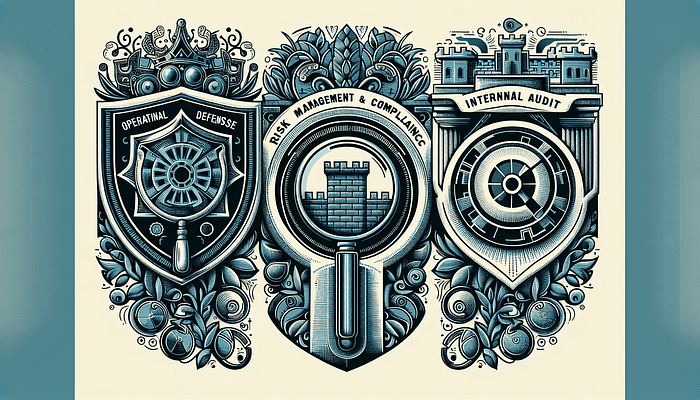What Are The First Second And Third Lines Of Defense Banking?
Understand how banks safeguard your interests with the Three Lines of Defense. Learn the roles of operational management, risk management, and internal audit.
What Are The First, Second, And Third Lines Of Defense Banking?
When it comes to ensuring the safety and integrity of banking operations, financial institutions rely on a robust framework known as the “Three Lines of Defense.” This approach helps banks identify, assess, and manage risks while ensuring compliance with the ever-evolving regulatory landscape. Understanding the fundamentals of these three lines of defense can empower you to recognize how your financial institution safeguards its operations and your interests.

The Three Lines of Defense: An Overview
At its core, the Three Lines of Defense model is a risk management and control mechanism applied within organizations. It is particularly crucial in the banking industry due to the sector’s inherent risks and regulatory requirements. The first line of defense consists of operational management, the second line of defense involves risk management and compliance functions, and the third line of defense is internal audit. Each line plays a vital role; let’s explore these in more detail.
The First Line of Defense: Operational Management
Operational management is the heartbeat of any bank. As the first line of defense, it includes the actions and roles of front-line employees and managers who are directly involved in day-to-day operations. This line carries out the practical implementation of risk control and management processes. They are responsible for identifying, assessing, and mitigating risks as they arise.
For example, a bank teller who verifies the identity of a customer before processing a transaction is a part of this first line of defense. By adhering to protocols and best practices, they help prevent fraud and ensure compliance with regulatory requirements.
The Second Line of Defense: Risk Management and Compliance
The second line of defense encompasses risk management and compliance functions. These are separate from the operational management and provide oversight and monitoring for the organization. Their primary role is to support the first line of defense by developing and enforcing policies, procedures, and controls to manage risks and ensure compliance with regulations.
In Utah, specific regulations such as the Utah Code Title 7 — Financial Institutions Act govern banking operations and compliance. For instance, under Utah Code § 7–1–204, banks are required to establish and maintain certain records and reports to aid in regulatory oversight. The second line of defense ensures that such requirements are met, thereby safeguarding the institution against various risks.
Pro Tip: A strong second line of defense can effectively reduce the burden on front-line employees, allowing them to focus on their core responsibilities without being overwhelmed by compliance issues.
The Third Line of Defense: Internal Audit
The third line of defense is internal audit. This function provides independent assurance by evaluating the effectiveness of the internal controls and risk management processes implemented by the first and second lines of defense. Internal auditors review and assess the adherence to policies, procedures, and regulatory requirements to ensure all is in check.
For example, in Salt Lake County, a major banking hub in Utah, internal auditors regularly conduct audits and report their findings directly to the audit committee of the board of directors. This layer of independent oversight is crucial for identifying deficiencies and recommending improvements to enhance the bank’s overall risk management framework.
Real-World Applications and Significance
Understanding these defenses can significantly impact your confidence in the banking sector’s stability and security. When you deposit money, you trust that the institution will safeguard your funds and personal information. The Three Lines of Defense model reassures you that banks have a structured approach to risk management and compliance.
Protecting Your Rights and Interests
Regulations are in place to ensure that banks operate fairly and transparently, protecting your rights as a customer. For example, the Utah Consumer Credit Code aims to protect consumers from unfair credit practices and ensure fair treatment. By establishing stringent compliance and regulatory frameworks within the second line of defense, banks can avoid practices that might otherwise lead to consumer harm.
Resolving Disputes
Disputes are inevitable in the banking sector. However, understanding the role of each defense line can empower you to navigate these conflicts more effectively. For instance, if you experience an unauthorized transaction, the first line of defense (customer service) will address your immediate concern, while the second line ensures that the bank follows appropriate procedures to resolve the issue. The third line, through internal audit, ensures that such incidents are thoroughly investigated to prevent recurrence.
Common Misconceptions
One common misconception is that the internal audit function within the third line of defense is the lone hero in identifying and rectifying issues within the bank. In reality, each line of defense is interdependent and collectively contributes to the institution’s risk management framework.
Another misconception is that regulatory compliance is solely the responsibility of the second line of defense. While the second line plays a significant role, operational management (the first line) is equally responsible for adhering to established policies and procedures.

Practical Applications and Takeaways
Embracing a holistic understanding of the Three Lines of Defense can better equip you to make informed decisions about your banking activities. Here are some actionable insights:
- Monitor Your Statements: Regularly check your bank statements for any discrepancies or unauthorized transactions. Knowing that the operational management (first line of defense) is your first point of contact for such issues can expedite resolutions.
- Understand Your Rights: Familiarize yourself with relevant regulations, such as the Utah Consumer Protection Act, to know your rights and remedies if you encounter unfair practices.
- Trust in Oversight: Trust that internal audit functions (third line of defense) perform thorough reviews to ensure that the bank’s risk management and compliance measures are effective and robust.
Want to know more about how these defenses work in practice? Here’s a great resource: West Jordan Lawyer Jeremy Eveland, who specializes in banking compliance and risk management, can provide deeper insights.
Frequently Asked Questions (FAQs)
- What constitutes good internal audit practices in banking?
- Effective internal audits include periodic, independent reviews, and adherence to best practices such as the Institute of Internal Auditors (IIA) standards.
- How do regulations like the Utah Code Title 7 affect banking operations?
- These regulations mandate stringent requirements for record-keeping, reporting, and operational procedures, thus ensuring transparency and accountability in banking operations.
- Are there penalties for non-compliance with Utah banking regulations?
- Yes, the Utah Department of Financial Institutions can impose penalties, including fines, sanctions, or other corrective actions, on banks that fail to comply with state regulations.
- What role do customers play in the Three Lines of Defense model?
- Customers play a crucial role in the first line of defense by staying vigilant, reporting suspicious activities, and understanding their rights to ensure effective risk management.
Final Thoughts and Takeaway
Understanding the Three Lines of Defense model in banking is essential to recognizing how financial institutions manage risks and protect your interests. Operational management, risk management and compliance, and internal audit are intricately linked to create a robust framework that ensures the safety and integrity of banking operations.
Why does this matter to you? By understanding these defenses, you can be more informed about how banks operate, protect your finances, and resolve issues. This knowledge enhances your confidence in managing your banking activities responsibly.
To speak with a criminal defense attorney, call Jeremy Eveland Utah Lawyer at (801) 613–1472.
If you found this article helpful, don’t forget to clap, leave a comment, and subscribe to our Medium newsletter for updates! Jeremy Eveland 8833 S Redwood Rd West Jordan Utah 84088 (801) 613–1472
The information contained in this article is for information purposes only and is not legal advice. For legal advice, hire a competent lawyer in your jurisdiction.
